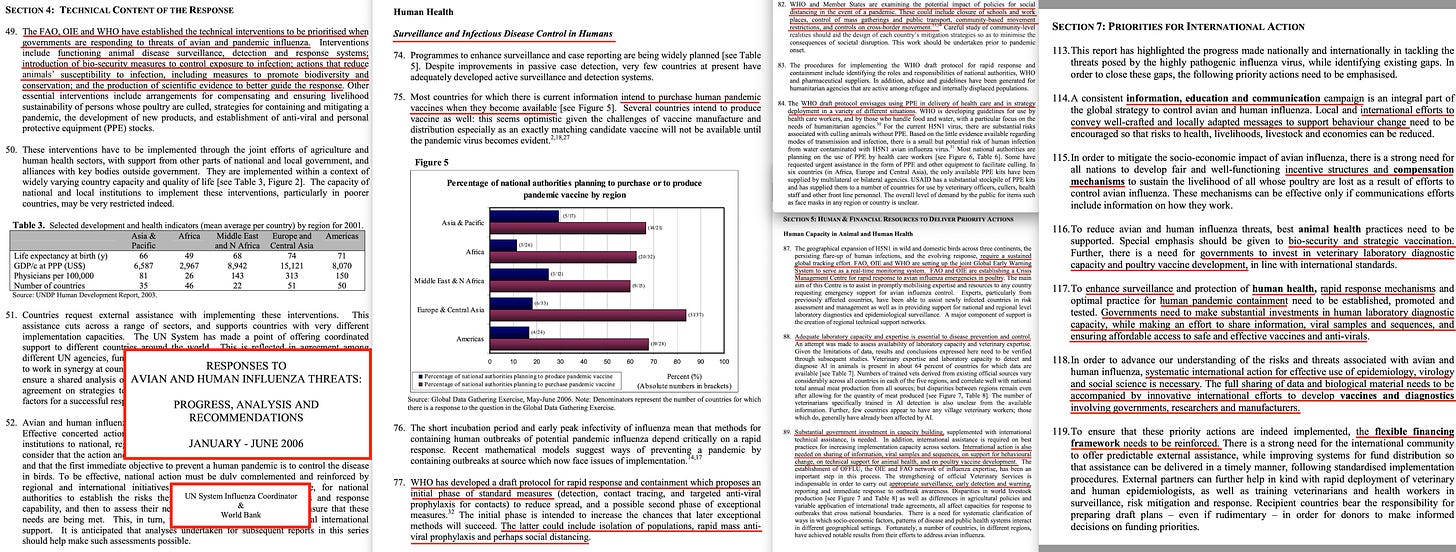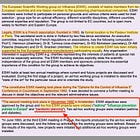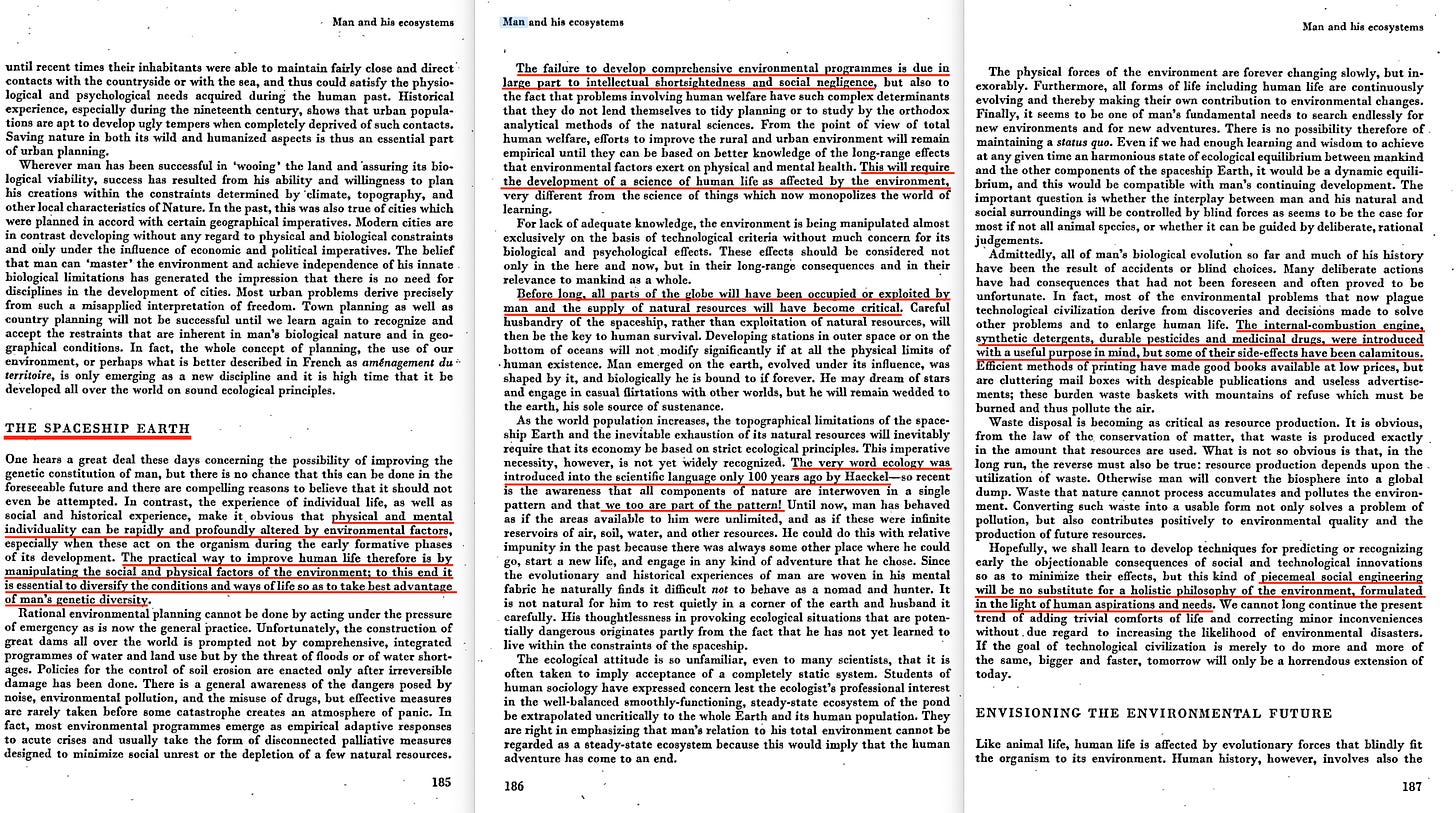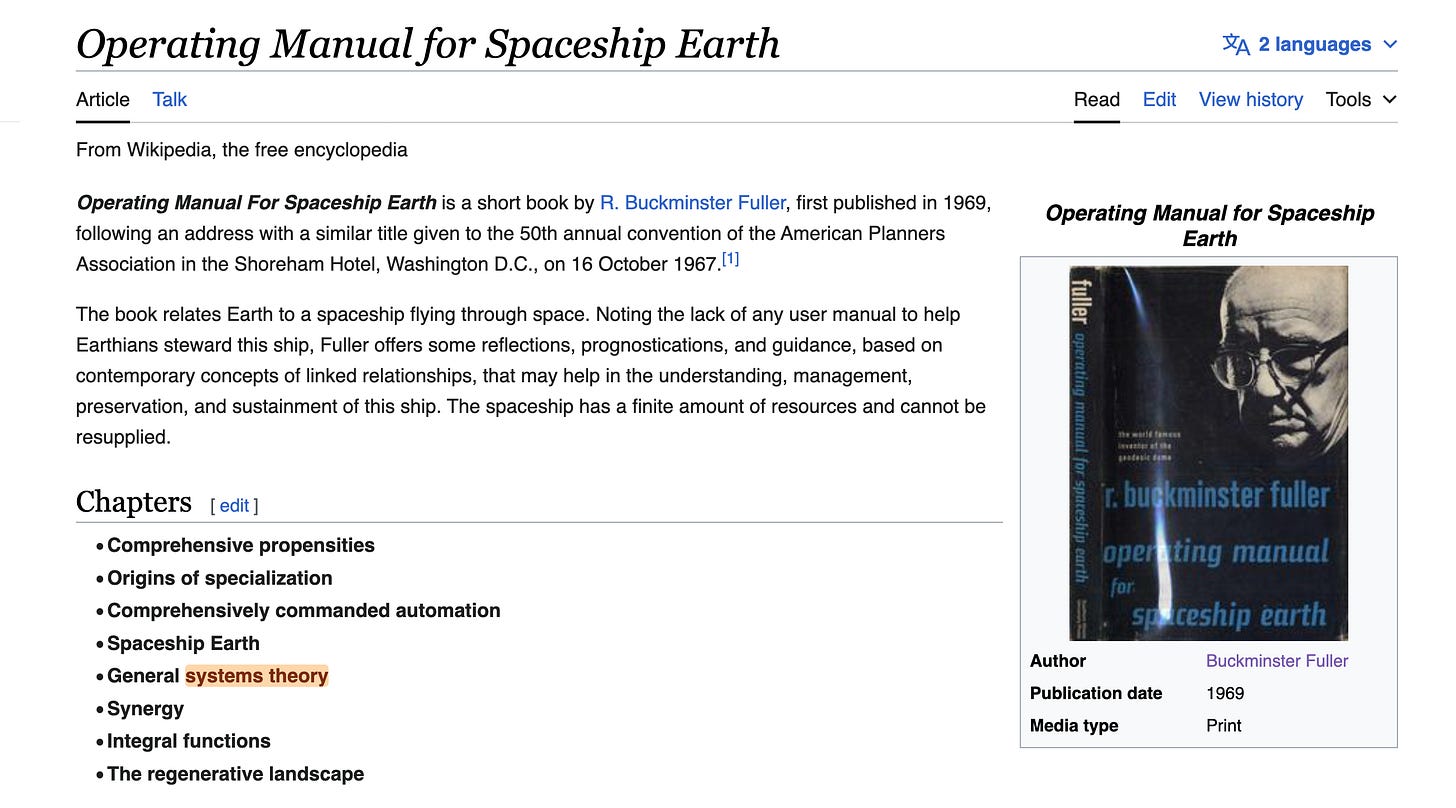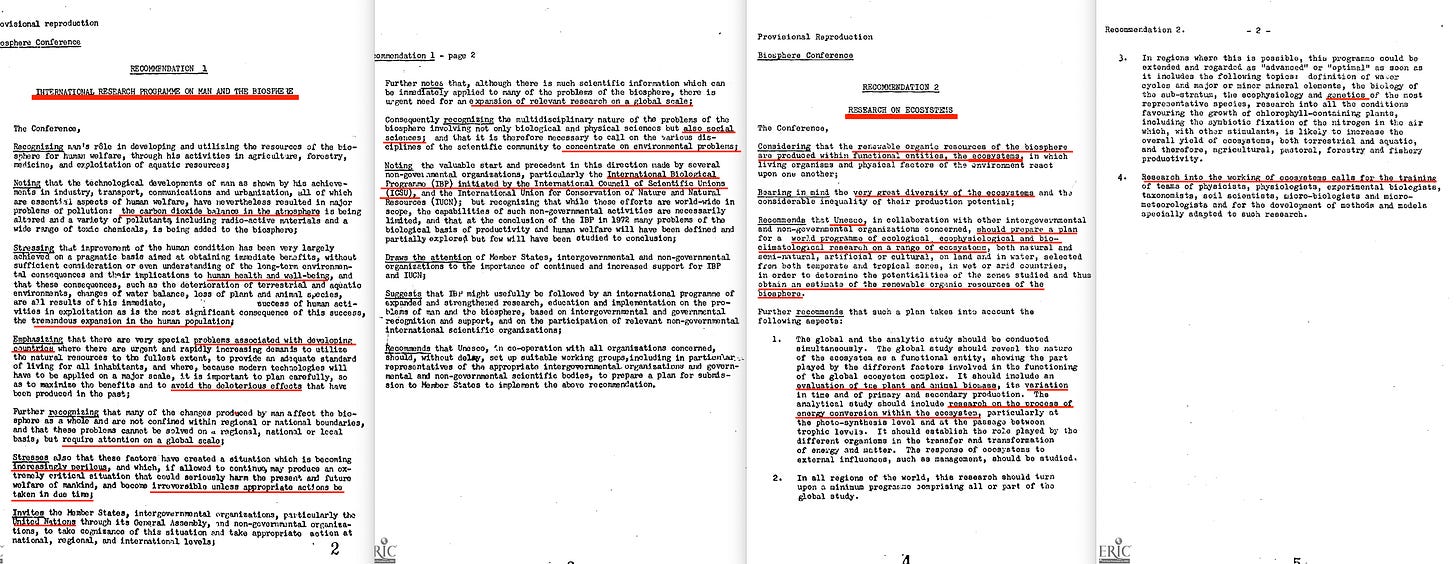The 1968 Launch Event
On a few occasions I have come across documents truly shocking. In a contemporary context, the first was upon my discovery of a 2006 UNSIC / World Bank document, in detail outlining the 2020 scamdemic plan. The second was reading SCOPE’s 3rd report on the Global Environmental Monitoring Systems, and the third was the 1968 UNESCO Use and Conservation of the Biosphere conference proceedings - because it is chock full of highly relevant information to this day.
-
Here’s the UNSIC / World Bank document from 2006. It includes quarantines, vaccines, school closures, and even social distancing. It even includes ‘biodiversity’ -
… of course, eventually that led to ancestor documents, and before landing in 1978 and William Foege’s Pandemic Plan (Foege, the CDC director who in 1984 went on to found the vaccine-focued Task Force for Child Survival, and who also introduced One Health to the masses in 2004), the ESWI and its absolutely undeniable influence became obvious, not least given them writing the 1999 WHO Pandemic Influenza Plan.
Since originally writing, I have gained a fair few subscribers (thank you); I would recommend reading, because it really does outline the gross levels of corruption within this industry.
The next absolutely incredible report was SCOPE’s 3rd; ‘Global Environmental Monitoring System’, released in 1973. The level of detail in their description of the contemplated, future global surveillance system is just absolutely staggering.
But inarguably the very worst - or best - is the 1968 UNESCO report on the Use and conservation of the biosphere. And why, will be systematically outlined in this article. Here’s the first article on the report -
But as this document isn’t technically covering new material, this article will be written in a slightly revised format. Detailed information will follow in the latter half; it’s there for people who seek detail - or in the event you question things are legitimately as crazy as suggested.
First off - this conference took place before there even was an official ‘consensus’ on the matter of carbon dioxide. In fact, this was 8 years before Bert Bolin at a US Senate hearing stated that pretty much the only thing they knew for sure, was that an increase in carbon dioxide led to an increase in plant growth.
So with all of that stated, here’s a condensed version of the 20 recommendations delivered in that document -
R1: Carbon emissions require taming through a global solution based on (social) science (fortuitously, the ICSU worked on this already).
R2-3: To establish man’s balance in the environment, research on man and ecosystems is required, including man’s health and well-being (more broadly), with an eye on zoonotic disease and drivers including environment change.
R4-5: Global data standards and regional data centres are called for, to enable a global inventory of natural assets. This database should be made available to systems analysts, and cover commodities and non-commodities, even nature reserves.
R6: Global surveillance is required to track pollutants (including carbon dioxide), and effect on media (water, soil, air). Policy to be formulated on this basis.
R7: Preservation of genetic resources, including variety and strain types. Protected areas to be established covering particular ecosystem types.
R8: Habitat destruction and general degradation call for rational use promotion. Specific resources should be evaluated before use, and soil restoration considered.
R9-13: With emphasis on youth, but inclusive of adults, education is required. This should include principles of ecology, and ecological thinking in general. To achieve, mass media should be engaged. Leaders to receive education in special centres, with access to other leaders, and the best science. UNESCO to supply information. To identify future needs and priorities, the FAO, WHO, WMO, ILO, IUCN, and ICSU stand ready to serve.
R14: Research and science policy should relate to the environment, and policy to be determined by state of natural resource, and be conducted in an economical manner. To create the best policy, responsible agencies should have access to the best scientific advise, and have the power to adjust policy.
R15: Biosphere reserves should be set aside for preservation. Work by the IBP and IUCN should be adopted, and carried forward.
R16: Multidisciplinary research and training centres should be created to evaluate, create inventories, and manage natural resources.
R17: A conference on problems of health and human environment is called for.
R18-19: Retargeted development aid to help nations without causing irreversible damage to the environment, and create institutions to aid this objective.
R20: Funding of the IBP and IUCN network of scientists is required to help develop a plan, outlining rational use and conservation of the biosphere. Coordination is required, calling for member nations, UN agencies and NGOs to collaborate.
-
First off, R17 calls for a conference - this was the 1972 United Nations Conference on the Human Environment in Stockholm, for which Maurice Strong commissioned the first SCOPE report, also covered in the article above. And the use of the mainstream media should be quite clear, as this is fairly pervasive in today’s society. And as for IBP, IUCN - the first was launched by the ICSU, and the latter by Huxley, who also launched UNESCO. Finally, a Systems Analysts slots right into the picture. I will get back to that in a minute.
We also have the mention of man’s balance with the environment. Those who have read either the Manhattan Principles - aka One Health - or even the latest Pandemic Treaty update should be familiar with this concept, as it was covered by both. And we also have -
Causes of destruction -
Man
Overpopulation. It’s that simple. Along goes overexploitation of nature, and overconsumption of natural non-renewable resources.Pollutants
These certainly fit within the global surveillance narrative; SCOPE 3 identifies the media for which to test certain pollutants, spanning air, oceans, lakes, rivers, and soil.Carbon Dioxide
Very little science existed in 1968 on the topic of ‘carbon dioxide = heating’ of the atmosphere, and no firm conclusion even existed as to whether the temperature was increasing, or declining. The eventual ICSU-organised 1979 narrative was established at an invite-only event, with indicatively biased papers.
Dangers -
Environmental change
The sales picth through the 1980s; global warming, climate change, etc.Zoonotic disease
With this script you should be familiar - 1976, 1997, 2003, 2009, 2020 - ie, Covid-19.
Solutions -
Global coordination
Intent here has always been to transfer power to the United Nations.(Social) Science
The ICSU and ISSC were both very active in these fields until their merger in 2018.Resource inventory
World Resources Institute, formed in 1982.Global surveillance
GEMS, 1971-76. Research by SCOPE, established by ICSU in 1969, the year following this conference.Global database
This eventually launched as GEMS GRID, in 1985.Protected areas / biosphere reserves
The UNESCO Man and the Biosphere Programme (MAB) launched in 1971.Rational use of natural resources
Sustainable development.Education
The ‘E’ in UNESCO.Science-driven policy
Not entirely sure here. Could possibly be the IIAS, but need to look further into this.Targeted Development Aid
Clearly the World Bank. Robert McNamara left his secretary of defense position to become the World Bank director in 1968, and in 1969, ‘Partners in Development’ was released; ‘The Pearson Report: a new strategy for global development‘.
Consequently, not only did this report lead to the development of FOUR initiatives (MAB, GEMS, WRI, and GRID), it also retargeted the efforts of the World Bank, established a new direction of scientific research, and used this to drive policy; considered the ‘education’ of the masses, utilised social science heavily in this educational rollout; outlined the need for a globally coordinated approach, and launched an early version of sustainable development.
And that is why I say that not only was this the official launch event, but this conference - and consequently this document - is also one of the most important in modern world history.
And this opinion of mine really isn’t changed in the slightest by the discovery in the full proceedings of a mention of the ‘Spaceship Earth’, which explicitly is a concept of systems theory.
… because ‘Spaceship Earth’ ultimately leads you here. With Barbara Ward'; ‘She was an early advocate of sustainable development before this term became familiar…‘
The UNESCO biosphere reserves then went on to become monetised through the GEF, the global surveillance progressively rolled out and merged with the zoonotic falsehoods, ultimately to become ‘One Health’, all while our kids were progressively brainwashed by increasingly social ‘science’ driven ‘sustainable development’ indoctrination in schools.
And with all of that said, here are the more detailed versions of the 20 recommendations.
-
Recommendation 1 - It is established that the carbon emissions are altering the balance of the biosphere, that this in turn impacts human health and well-being, that we experience an expansion in global population - especially in the developing world, that the issue should be solved globally as opposed to locally, that’s it’s an emergency, research is required to solve said issue, that the research should include a social (science) dimension, and that ICSU’s IBP has already worked in this field for a while.
Recommendation 2 - Research should pay particular attention to ecosystems, the diversity, genetics, organic resources, and process of energy conversion within, leading to training of relevant scientists, and production of related mathematical models.
Recommendation 3 - Research should also include man, as he’s an integral part of the environment - include his mental health, social and physical adaptability, human diseases, especially zoonotic ones and those driven by environmental change with an aim to establish man’s balance within the environment for sakes of his health and well-being ‘in their broadest connotations’.
Recommendation 4 - Establish an inventory of resources, including quantity and quality, and introduce monitoring of stock. This should further lead to global data standards and procedures, enabling international collaboration and exchange of information. UNESCO is requested to draw up a list of resources to be considered, the purpose of each included resource is to be detailed, and these should include commodities, as well as non-commodities like natural areas, or research reserves.
Recommendation 5 - In addition to the establishment of global standards for the exchange of data, calibration, this standardisation process should further be applied to communication, and this furthermore requires storage, along with elaboration of information. We should have more recording stations, remote sensing should be deployed, typification and classification systems should be developed, and regional storage systems should be put in use, and all this information should be made available to specialists - including systems analysts.
Recommendation 6 - Pollutants should be monitored, especially one created from combustion, those which transport over large distances, are long-lasting, accumulates in the biosphere, as well as pesticides and fertilisers. This should be solved through a global monitoring system, and this in turn calls for intergovernmental co-operation. UNESCO is requested to draw up a list of ‘actually or potentially’ involved substances - including those linked to combustion - and all of this should be using uniform terminology and methods to ensure compatible data. Monitoring should extend to air, soil, water and living organisms, will adopt remote sensing technologies, determine levels of pollutants considered dangerous, study the movement and degradation of said, prevent and control, even reduce their current levels, and create regulation specific to the introduction of pollutants in the environment.
Recommendation 7 - Genetic resources must be used and preserved, especially in the light of the growing interest in targeted evolution techniques. We further require ecosystem preservation, the establishment of protected areas, representing particular ecosystem types and where species exist liable for extinction. Finally, the full range of variety and strains must be included in this effort.
Recommendation 8 - Due to the issue of habitat destruction and general degradation of the environment, rational use of natural resources should be promoted, taking into account the effect of the use of said resources in the first place, ensuring the permanence of the biosphere in the process. Possible use of the resources should be evaluated, and their potential for use identified. Soil restoration should be considered, as should lands deteriorated due to fire or accelerated erosion.
Recommendation 9 - Education is required for primary and secondary level school children on the topic of ecology, and ecological thinking. Teachers should be brought up to speed, and those responsibile for environmental education in general need to attend workshops. UNESCO will cooperate by supplying material and information in general.
Recommendation 10 - Ecology will also require teching at university level urgently. An ecological approach further needs introducing in the education of all professionals, such as teachers, biologists, architects, economicst, sociologists, and anyone in fact even remotely connected to the use of resources of the biosphere.
Recommendation 11 - Leaders need training in this rational use as well, and said should take place in centres, collaborating with counterparts in other nations, for sakes of free flow of information.
Recommendation 12 - Youths and adults out of education should be brought to understand the broad econological principles, man’s positioning within the environment, and for this purpose, youth participation is encouraged, and mass media engaged for this purpose.
Recommendation 13 - The FAO, WHO, WMO, ILO, IUCN, and ICSU should serve in the capacity of identifying future educational needs, establishing priority for action, recommending on the division of responsibility, and specific projects of undertaking.
Recommendation 14 - Research and science policy should include management of the environment, the inventory of resources should determine policy, resoure policy should be conducted in an economical manner, and an approproate mechanism should be setup to ensure that access to the best scientific advice is available for the sakes of setting policy. Further, said policy should be commonly be reviewed, and the agency have the power to continuously adjust guidelines and policy goals.
Recommendation 15 - Biosphere reserves should be set aside for the preservation of species and habitats, and these should be representative of ecosystems in general. The IUCN and IBP have already worked in this capacity, and their work should be carried forward.
Recommendation 16 - For the sakes of the evaluation of and producing inventories, multidisciplinary research and training centres should be created, focusing on the management of said resources.
Recommendation 17 - A conference is called for on the topic of problems of human environment. (Stockholm, 1972)
Recommendation 18 - Developing nations need help doing natural resource inventories, and multilateral assistance could be restuctured in alignment with this objective.
Recommendation 19 - Developing nations, due to lack of manpower as well as financial constraints, require attention as their rapid - but necessary - development has the potential of causing irreversible damage to the environment. This could lead to investment projects by UN agencies considering external advice on the selection on experts and projects, include ecological considerations, with a targeted effort to simply mechanisms of cross-border project implementations, and even consider education and creation of institutions.
Recommendation 20 - An interdisciplinary programme is called for which will be required to call on existing knowledge, consider both developed and developing nations, that the IBP and IUCN’s existing networks of scientists require funding, a plan should be prepared for the rational utilisation and conservation, this should be intergovernmental, and include NGOs. This effort should focus on the scientific, technical and educational aspects of the problems, and a coordination machinery for this effort should exist, including member states, along with United Nation agencies, and NGOs.



